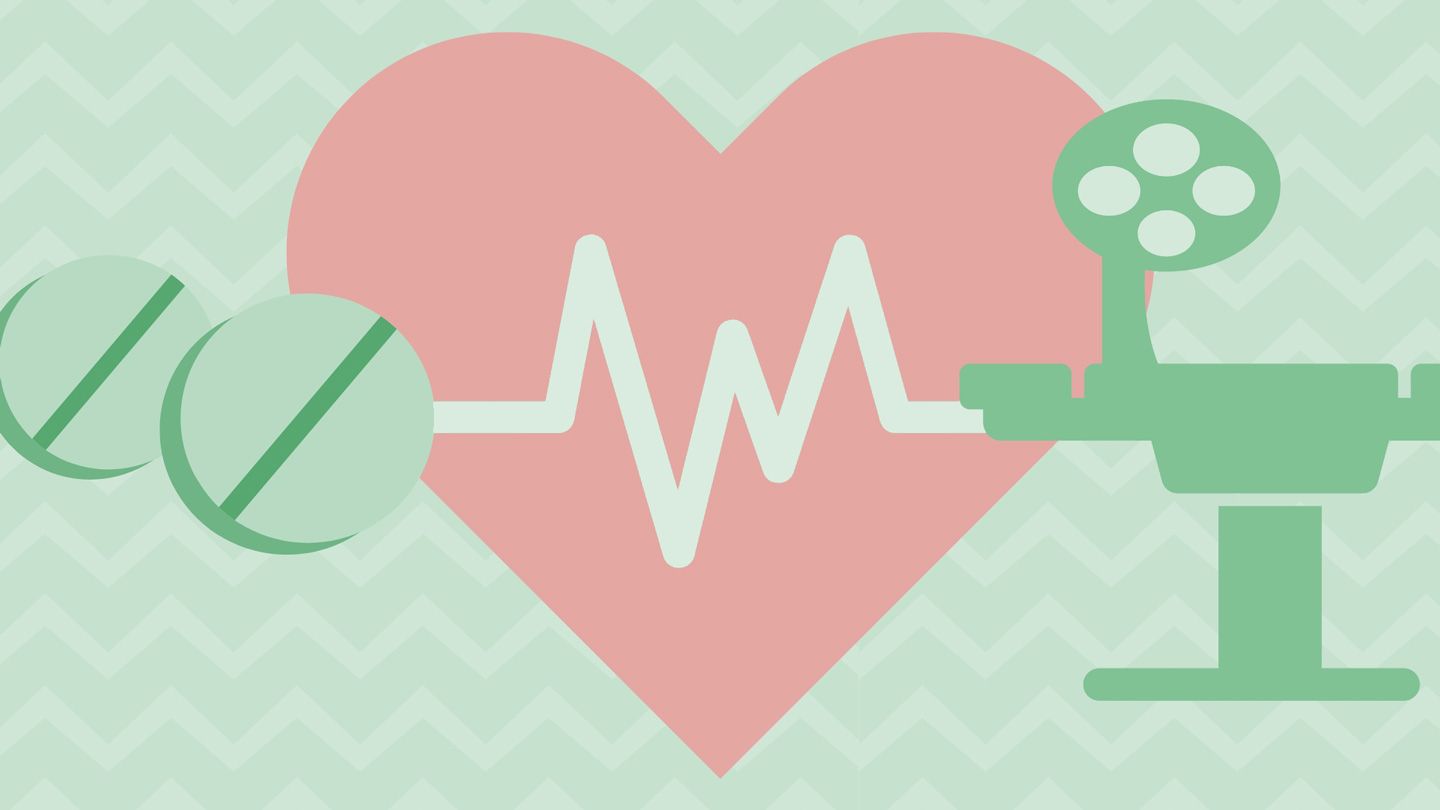Atrial fibrillation (afib) is a type of arrhythmia , or irregular heartbeat, in which the upper chambers of the heart don’t pump effectively. As a result, blood can pool in that area and raise the risk of serious complications such as blood clots , heart failure , or stroke .e60dc2a1-f33c-4a05-9b50-8e3e8e597629ca1df11b-592f-4063-98af-a9fed2779dce If you’re one of the roughly 12 million people in the United States living with afib,e60dc2a1-f33c-4a05-9b50-8e3e8e597629bc1b5999-3d2a-441e-b445-a49d46eb296e proper treatment can restore a regular heart rhythm, manage symptoms, and reduce your risk of complications. But it’s important to understand what treatment options are available and work closely with your doctor to find the right regimen for you.e60dc2a1-f33c-4a05-9b50-8e3e8e5976296a496dd9-695b-40bc-8633-a14a0ce5b6fe
The Benefits of Catheter Ablation Ablation A catheter ablation is a minimally invasive procedure in which a flexible tube is inserted into a vein in your groin, arm, neck, or upper thigh. This tube delivers radiofrequency energy to destroy abnormal heart tissue and restore a more regular heart rhythm.e60dc2a1-f33c-4a05-9b50-8e3e8e59762947c4a095-13c4-45e4-b140-bc7eff726499 Historically, doctors treated afib with medications first. If that was unsuccessful, the next step would be catheter ablation, explains Oussama Wazni, MD , the section head of cardiac electrophysiology and pacing at Cleveland Clinic. “But the overwhelming evidence now is that people may be better off considering ablation right away.” More and more research shows that ablation maintains normal rhythm more effectively than antiarrhythmic drugs, and may also prevent hospitalizations, and thus should be considered a firstline therapy for afib.e60dc2a1-f33c-4a05-9b50-8e3e8e597629a5c97133-efa3-4742-bc61-ba2d2685b4bde60dc2a1-f33c-4a05-9b50-8e3e8e5976293c8d1c69-e146-4a13-a57e-c0d8ce9131d7 Ablation also comes with other potential benefits and risks. Reduction of Afib Symptoms One of the main reasons for a cardiac ablation is to control symptoms such as shortness of breath or heart palpitations and improve quality of life.e60dc2a1-f33c-4a05-9b50-8e3e8e5976293fb8b140-220c-4dd0-b004-3c7668e00a9d Research shows that catheter ablation leads to significant improvements in quality of life in people with symptomatic afib in the year after the procedure.e60dc2a1-f33c-4a05-9b50-8e3e8e5976295c170e0f-615f-435a-87f5-81d8eb5880cf It may also reduce the frequency and duration of afib episodes over the course of five years in young adults.e60dc2a1-f33c-4a05-9b50-8e3e8e5976292bbd0b7f-529e-4de4-b122-ddcab9aef6e9 People often seek care from their doctors for symptom relief, says Dr. Wazni, and addressing afib symptoms is an essential part of treatment. Potential to Avoid Long-Term Medication Ablation may lead to decreased reliance on atrial fibrillation medications. In fact, data shows that nearly 90 percent of people with afib no longer needed antiarrhythmic drugs after the procedure.e60dc2a1-f33c-4a05-9b50-8e3e8e5976298b96247c-accf-463c-bff4-f38faeb5dcc7 Ablation could also prevent afib from becoming more persistent or permanent, which can be much more difficult to treat and manage, adds Wazni. Risks and Side Effects While a catheter ablation treats atrial fibrillation, it does come with certain risks and side effects, which include:e60dc2a1-f33c-4a05-9b50-8e3e8e59762966b35d1d-c054-4c45-83d2-77933f5fd2d2e60dc2a1-f33c-4a05-9b50-8e3e8e59762983776533-c57d-4ebb-86c5-9eceaa82a989 Bleeding or infection at the catheter insertion site Damage to a blood vessel or heart valve A new or worsening arrhythmia A slowed heart rate that requires additional treatment Blood clot in the lungs or legs Stroke or heart attack Pulmonary vein stenosis, or a narrowing of the veins that carry blood between the heart and lungs Kidney damage from contrast dye used during the procedure But the exact risks depend on various factors, such as the type of ablation and why it’s done. And success rates for this procedure are high. So it’s important to discuss the exact risks and benefits with your doctor to determine whether or not you should undergo an ablation for atrial fibrillation.
Ablation vs. Other Medical Procedures Other Medical Procedures Other noninvasive and invasive interventions may be used to treat and manage atrial fibrillation. Cardioversion Cardioversion is a nonsurgical procedure that uses quick, low-energy shocks to restore the heart’s rhythm if it beats irregularly or too quickly. Two types of cardioversion can be used to treat atrial fibrillation:e60dc2a1-f33c-4a05-9b50-8e3e8e597629c526d4a1-356a-481b-8456-9a3352cccb96 Electrical cardioversion uses a machine with sensors to deliver a low-energy electrical shock to the chest to quickly restore normal heart rhythm. Pharmacological cardioversion , also called chemical cardioversion, uses medication rather than shocks to reset the abnormal heart rhythm. It takes longer to do so than an electrical cardioversion. “Cardioversion is an acute intervention to restore normal rhythm,” says Wazni. “It does not maintain the normal heart rhythm or prevent the recurrence of atrial fibrillation.” If you have this procedure, ablation or medication will still be needed to treat afib. Pacemaker Implantation A pacemaker is a small, battery-operated device that uses an electrical signal to help your heart beat at a healthier rhythm. While it’s not typically used to treat atrial fibrillation, there may be some cases where it’s part of your management plan. For example, if your heart rate outside of afib is very slow, or if you also have heart failure, you may need a pacemaker to keep a normal heart rhythm.e60dc2a1-f33c-4a05-9b50-8e3e8e5976293a2c2583-999b-4633-8777-5dd7b43f5761 “A pacemaker is an adjunct therapy to help manage afib — it does not get rid of or treat afib,” says Wazni.
What to Know About Antiarrhythmic Drugs Drugs Drugs were once considered the standard treatment for afib, but the conventional wisdom on when and how to use them to regulate heart rhythm has shifted. “A few years ago, we would always use antiarrhythmic drugs, and if those failed, we’d do the ablation,” says Wazni. “But now the landscape has changed to the point where we can do an ablation first. However, if the ablation doesn’t work — if the atrium is very diseased or has a lot of scar tissue — the ablation may not be successful on its own. And at that point, we may add an antiarrhythmic drug.” There are several drugs that may be prescribed to control heart rate and prevent complications related to afib. Beta-Blockers Beta-blockers have been used for decades as a first line therapy to help normalize a fast heart rate and treat arrhythmias like afib. They work by blocking the effects of the hormone epinephrine , also known as adrenaline, which helps lower blood pressure and widen veins to improve blood flow. Options include atenolol, metoprolol, and nadolol.e60dc2a1-f33c-4a05-9b50-8e3e8e5976296d609d66-abdf-4f48-a4c3-007ff5d1280ce60dc2a1-f33c-4a05-9b50-8e3e8e5976298b1049b8-44d0-4b07-9a07-1b8f06c098a7 Beta-blockers come with certain risks and side effects, including:e60dc2a1-f33c-4a05-9b50-8e3e8e5976298b1049b8-44d0-4b07-9a07-1b8f06c098a7 Cold hands and feet Depression Dizziness or lightheadedness Shortness of breath Trouble sleeping Weight gain While they continue to be prescribed to treat afib,e60dc2a1-f33c-4a05-9b50-8e3e8e5976296d609d66-abdf-4f48-a4c3-007ff5d1280c some research notes that there’s no long-term safety and efficacy data around the use of beta-blockers to treat this condition, and the potential risks and side effects may not be worth it when other more favorable treatments are available.e60dc2a1-f33c-4a05-9b50-8e3e8e597629c293bb63-dbf3-4af6-bc2f-4432f15091a8 Calcium Channel Blockers Calcium channel blockers are drugs that prevent calcium from entering cells in the heart and arteries, which allow blood vessels to relax and open. As a result, calcium channel blockers can help slow heart rate in people who have atrial fibrillation. Options include diltiazem and verapamil.e60dc2a1-f33c-4a05-9b50-8e3e8e59762949a8567b-a8b9-4540-a485-88ea833ec5b9e60dc2a1-f33c-4a05-9b50-8e3e8e59762901dd0f9d-e4a1-4bd2-9590-2b44f7a510d5 Calcium channel blockers come with certain risks and side effects, including: Constipation Dizziness Fast heartbeat Flushing Headache Nausea Swelling in the feet and ankles Tiredness Research shows that calcium channel blockers may be less likely than beta-blockers to slow heart rate too much when used for people with nonpermanent afib.e60dc2a1-f33c-4a05-9b50-8e3e8e59762913de9f2a-0c8b-4744-88ce-f55e639760af Digoxin Digoxin falls within the class of heart medicines known as digitalis glycosides.e60dc2a1-f33c-4a05-9b50-8e3e8e597629d90ae861-d854-4163-b419-4131cb0aadfc When you have atrial fibrillation, digoxin may be prescribed to slow electrical signals in the heart and decrease your heart rate.e60dc2a1-f33c-4a05-9b50-8e3e8e59762935a707e5-2d7d-447d-9efe-475a62a8f4c8 Digoxin may come with certain risks and side effects, which include: Blurry or discolored vision Dizziness or lightheadedness Enlarged male breast tissue Headache Sleepiness Skin rash Upset stomach Other issues with heart rate or rhythm Digoxin may also lead to an increased risk of sudden death in people with afib, so other treatments may be recommended first.e60dc2a1-f33c-4a05-9b50-8e3e8e59762959240ed3-c331-4b09-a242-c2e572af9f50 Blood Thinners Atrial fibrillation can cause blood to pool in the heart, which increases your risk of developing a blood clot that can then travel to your brain and cause a stroke. Blood thinners, such as coumadin (Warfarin) don’t treat atrial fibrillation directly, but they may be prescribed to help prevent blood clots from forming, and in turn, reduce your risk of a stroke.e60dc2a1-f33c-4a05-9b50-8e3e8e5976295105e3db-1d6b-45d6-9a33-513fd1527829 Blood thinners can lower the risk of stroke in people with atrial fibrillation by up to 66 percent.e60dc2a1-f33c-4a05-9b50-8e3e8e5976299043bfcf-10d2-4087-9560-0ea35af873fe A notable side effect that comes with blood thinners is an increased risk of bleeding. But a study led by Wazni found that a minimally invasive procedure called a left atrial appendage closure (which can even be done during a catheter ablation) resulted in significantly less bleeding than blood thinners — all while preserving the benefits of reduced stroke risk.e60dc2a1-f33c-4a05-9b50-8e3e8e597629dcf82e28-40c9-490b-aa88-928fa3356c08 “Even if you have a successful ablation, the risk of stroke is still moderate to high,” says Wazni, who emphasizes that continuing to take steps to reduce stroke remains essential.
How to Decide on Treatment How to Choose When you have atrial fibrillation, it’s important to work closely with your doctor to come up with the right treatment and management plan. “It’s a shared decision process,” emphasizes Wazni. You’ll want to consider factors such as:e60dc2a1-f33c-4a05-9b50-8e3e8e597629fd77ad09-bb41-4056-8494-204d7188a002 The type of atrial fibrillation you have Your afib symptoms Your age Your overall health (including any other health conditions you may have)
Questions to Ask Your Doctor What type of atrial fibrillation do I have? Am I a good candidate for catheter ablation?Are there other afib treatments I should try before ablation? What signs of stroke should I be aware of?How do I know if my treatment is working?How often should I schedule afib checkups?Are there any lifestyle changes that may also help me manage afib and stroke risk?
The Takeaway Catheter ablation is a minimally invasive, highly successful procedure that can be used as a first-line treatment for atrial fibrillation to help restore normal heart rhythm. Other treatment options, including medications like beta-blockers or calcium channel blockers, may also be used to treat afib in some cases. While atrial fibrillation can increase your risk of stroke, blood thinners or a procedure called left atrial appendage closure may reduce stroke risk. Make decisions in partnership with your doctor to determine the atrial fibrillation treatment regimen that’s right for you.
Read the full article here
Leave a comment




